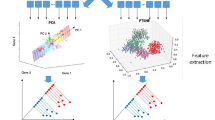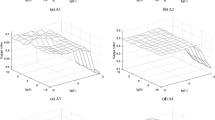Abstract
Feature extraction and classification is a vital part in motor imagery-based brain-computer interface (BCI) system. Traditional deep learning (DL) methods usually perform better with more labeled training samples. Unfortunately, the labeled samples are usually scarce for electroencephalography (EEG) data, while unlabeled samples are available in large quantity and easy to collect. In addition, traditional DL algorithms are notoriously time-consuming for the training process. To address these issues, a novel method of hierarchical semi-supervised extreme learning machine (HSS-ELM) is proposed in this paper and applied for motor imagery (MI) task classification. Firstly, the deep architecture of hierarchical ELM (H-ELM) approach is employed for feature learning automatically, and then these new high-level features are classified using the semi-supervised ELM (SS-ELM) algorithm which can exploit the information from both labeled and unlabeled data. Extensive experiments were conducted on some benchmark datasets and EEG datasets to evaluate the effectiveness of the proposed method. Compared with several state-of-the-art methods, including SVM, ELM, SAE, H-ELM, and SS-ELM, our HSS-ELM method can achieve better classification accuracy, a mean kappa value of 0.7945 and 0.5701 across all subjects in the training and evaluation sessions of BCI Competition IV Dataset 2a, respectively. Finally, it comes to the conclusion that the proposed method has achieved superior performance for feature extraction and classification of EEG signals.

The schematic of the proposed HSS-ELM algorithm.




Similar content being viewed by others
References
Wolpaw J, Wolpaw E W (2012) Brain-computer interfaces: principles and practice. OUP USA
Pfurtscheller G, Neuper C (2001) Motor imagery and direct brain-computer communication. Proc IEEE 89(7):1123–1134
Sanei S, Chambers J A (2013) EEG signal processing. John Wiley & Sons
Samek W, Kawanabe M, Müller KR (2014) Divergence-based framework for common spatial patterns algorithms. IEEE Rev Biomed Eng 7:50–72
She Q, Gan H, Ma Y et al (2016) Scale-dependent signal identification in low-dimensional subspace: motor imagery task classification. Neural Plast 7431012
Thomas E, Fruitet J, Clerc M (2013) Combining ERD and ERS features to create a system-paced BCI. J Neurosci Methods 216(2):96–103
Park C, Looney D, ur Rehman N et al (2013) Classification of motor imagery BCI using multivariate empirical mode decomposition. IEEE Trans Neural Syst Rehab Eng 21(1):10–22
Ang KK, Chin ZY, Wang C et al (2012) Filter bank common spatial pattern algorithm on BCI competition IV datasets 2a and 2b. Front Neurosci 6:39
Park C, Took CC, Mandic DP (2014) Augmented complex common spatial patterns for classification of noncircular EEG from motor imagery tasks. IEEE Trans Neural Syst Rehab Eng 22(1):1–10
Djemal R, Bazyed AG, Belwafi K et al (2016) Three-class EEG-based motor imagery classification using phase-space reconstruction technique. Brain Sci 6(3):36
Bhattacharyya S, Khasnobish A, Chatterjee S et al (2010) Performance analysis of LDA, QDA and KNN algorithms in left-right limb movement classification from EEG data. Proc IEEE Int Conf Syst Med Biol 126–131
Übeyli ED (2009) Combined neural network model employing wavelet coefficients for EEG signals classification. Digital Signal Process 19(2):297–308
Wipf D, Nagarajan S (2009) A unified Bayesian framework for MEG/EEG source imaging. NeuroImage 44(3):947–966
Huang GB, Zhu QY, Siew CK (2006) Extreme learning machine: theory and applications. Neurocomputing 70(1):489–501
Huang GB, Zhou H, Ding X et al (2012) Extreme learning machine for regression and multiclass classification. IEEE Trans Syst Man Cybern B (Cybernetics) 42(2):513–529
Zong W, Huang GB, Chen Y (2013) Weighted extreme learning machine for imbalance learning. Neurocomputing 101:229–242
Lendasse A, He Q, Miche Y et al (2014) Advances in extreme learning machines (ELM2012). Neurocomputing 128:1–3
Duan L, Bao M, Miao J et al (2016) Classification based on multilayer extreme learning machine for motor imagery task from EEG signals. Procedia Comput Sci 88:176–184
Ding S, Zhang N, Xu X et al (2015) Deep extreme learning machine and its application in EEG classification. Math Probl Eng 2015
Peng Y, Lu BL (2016) Discriminative manifold extreme learning machine and applications to image and EEG signal classification. Neurocomputing 174:265–277
Zhang Y, Jin J, Wang X et al (2016) Motor imagery EEG classification via Bayesian extreme learning machine. Proc IEEE Int Conf Inf Sci Technol (ICIST) 27–30
Tang J, Deng C, Huang GB (2016) Extreme learning machine for multilayer perceptron. IEEE Trans Neural Netw Learn Syst 27(4):809–821
Kasun LLC, Zhou H, Huang GB et al (2013) Representational learning with ELMs for big data. IEEE Intell Syst 28(6):31–34
Uzair M, Shafait F, Ghanem B et al (2015) Representation learning with deep extreme learning machines for efficient image set classification. arXiv preprint arXiv:1503.02445
Zhou Y, Liu B, Xia S et al (2015) Semi-supervised extreme learning machine with manifold and pairwise constraints regularization. Neurocomputing 149:180–186
Huang G, Song S, Gupta JND et al (2014) Semi-supervised and unsupervised extreme learning machines. IEEE Trans Cybern 44(12):2405–2417
Yu W, Zhuang F, He Q et al (2015) Learning deep representations via extreme learning machines. Neurocomputing 149:308–315
Gan H, Luo ZZ, Meng M et al (2016) A risk degree-based safe semi-supervised learning algorithm. Int J Mach Learn Cybern 7(1):85–94
Belkin M, Niyogi P, Sindhwani V (2006) Manifold regularization: a geometric framework for learning from labeled and unlabeled examples. J Mach Learn Res 7(Nov):2399–2434
Hinton GE, Salakhutdinov RR (2006) Reducing the dimensionality of data with neural networks. Science 313(5786):504–507
Vincent P, Larochelle H, Bengio Y et al (2008) Extracting and composing robust features with denoising autoencoders. Proceedings of the 25th International Conference on Machine Learning, 1096–1103
Vincent P, Larochelle H, Lajoie I et al (2010) Stacked denoising autoencoders: learning useful representations in a deep network with a local denoising criterion. J Mach Learn Res 11(Dec):3371–3408
Salakhutdinov R, Larochelle H (2010) Efficient learning of deep Boltzmann machines. Proc Int Conf Artif Intell Stat 693–700
LeCun Y, Bengio Y, Hinton G (2015) Deep learning. Nature 521(7553):436–444
Blake CC, Merz CJ UCI repository of machine learning databases. Available online: http://archive.ics.uci.edu/ml/
The Yale Face Database Available online: http://vision.ucsd.edu/content/yale-face-database
Graz University BCI Competition IV Datasets 2a. Available online: http://www.bbci.de/competition/iv/#dataset2a
Meng M, Zhu J, She Q et al (2016) Two-level feature extraction method for multi-class motor imagery EEG. Acta Automat Sin 42(12):1915–1922
Längkvist M, Karlsson L, Loutfi A (2012) Sleep stage classification using unsupervised feature learning. Adv Artif Neural Syst 2012:5
Wu W, Chen Z, Gao X et al (2015) Probabilistic common spatial patterns for multichannel EEG analysis. IEEE Trans Pattern Anal Mach Intell 37(3):639–653
Acknowledgments
This work is supported by National Nature Science Foundation under Grant (No.61201302, 61671197 and 61601162), Zhejiang Province Natural Science Foundation (LY15F010009), Guangdong Provincial Work Injury Rehabilitation Center and the University of Houston. The authors would like to acknowledge the BCI Competition IV Dataset 2a which was used to test the algorithms proposed in this study.
Author information
Authors and Affiliations
Corresponding authors
Ethics declarations
Conflict of interests
The authors declare that they have no conflict of interests.
Rights and permissions
About this article
Cite this article
She, Q., Hu, B., Luo, Z. et al. A hierarchical semi-supervised extreme learning machine method for EEG recognition. Med Biol Eng Comput 57, 147–157 (2019). https://doi.org/10.1007/s11517-018-1875-3
Received:
Accepted:
Published:
Issue Date:
DOI: https://doi.org/10.1007/s11517-018-1875-3




